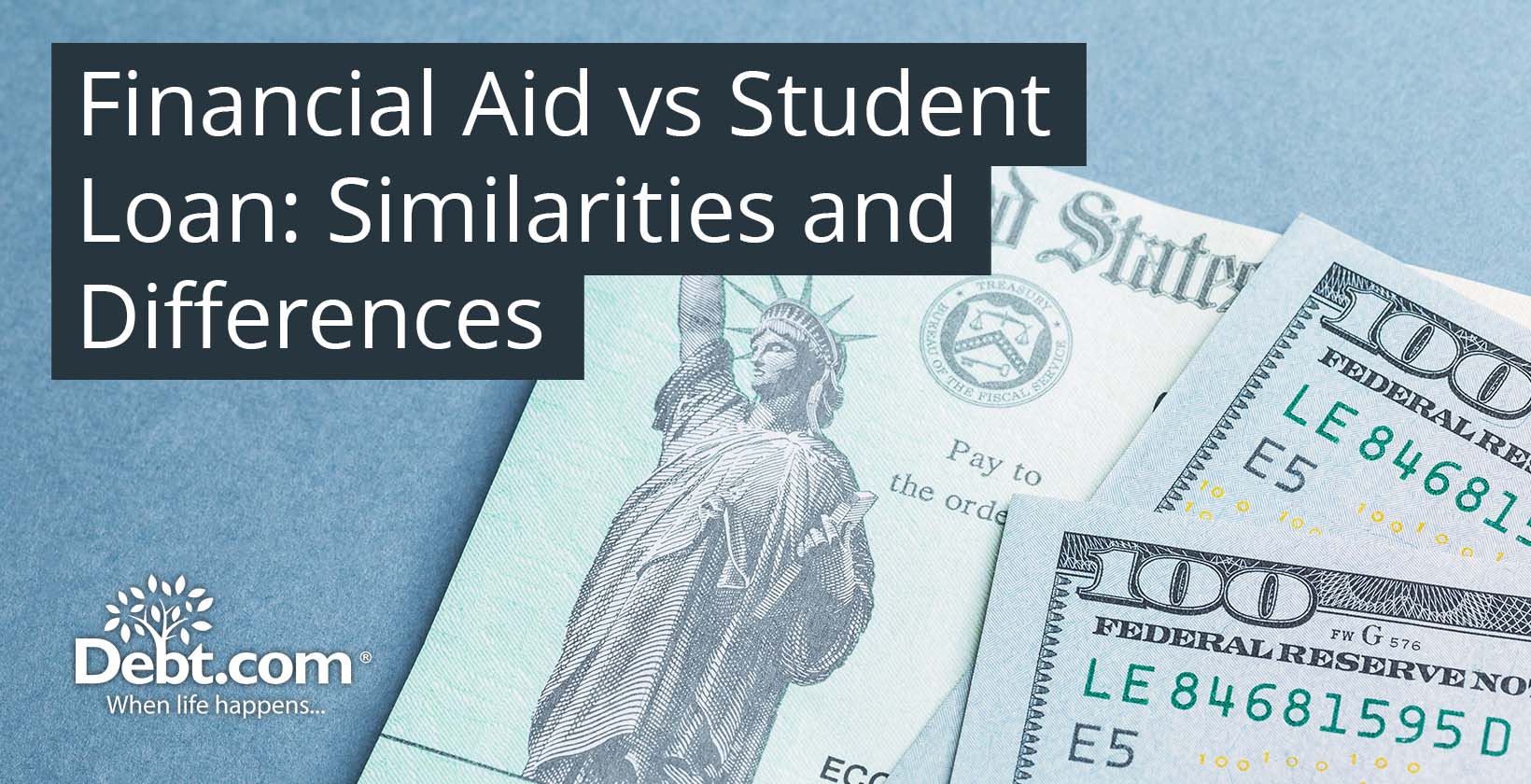
Financial aid vs student loans presents a critical comparison for understanding the alternatives for financing college. Financial aid and student loans help cover education-related expenses, including tuition, books, supplies, room and board, and transportation. Students must submit the Free Application for Federal Student Aid (FAFSA®) to determine federal student loans and financial aid eligibility. The form assesses the student’s financial status.
The primary distinction between financial aid vs loans lies in repayment. Financial aid, such as grants and scholarships, does not require repayment. Student loans must be repaid with interest over a specified loan term. Financial aid is based on financial need, merit, or a combination. Federal student loans are categorized into need-based (e.g., Direct Subsidized Loans) and non-need-based (e.g., Direct Unsubsidized Loans). Private student loans depend on the borrower’s creditworthiness and require a cosigner.
Student loans are disbursed in lump sums at the start of the academic term, whereas financial aid, like grants and scholarships, is disbursed in multiple installments or directly applied to tuition and fees by the institution. Financial aid provides funds without accruing debt, while student loans increase financial obligations after graduation. Defaulting on student loans leads to severe consequences, such as damaged credit and wage garnishment, whereas losing financial aid does not have such direct negative impacts.
Private student loans offer greater flexibility and larger loan amounts compared to financial aid packages in the student loan vs financial aid, which are capped based on need and available funds. The student loans vs financial aid debate highlight that are crucial for funding education, serving different functions with distinct responsibilities and benefits. Financial aid provides non-repayable funds, whereas student loans offer essential financial support but require careful planning and repayment with interest.
Table of Contents
Financial aid is money students receive to help them pay for their college education. The goal is to make college more affordable so that more families and students realize their academic potential.
Financial aid comes in various forms, including scholarships, grants, work-study programs, and loans. Grants and scholarships are paid without being repaid and are awarded according to financial need or merit. Work-study programs provide part-time jobs for students, allowing them to earn money to support their education. Loans must be repaid with interest and come from federal or private sources.
The federal government, individual states, colleges and universities, nonprofits, and for-profits comprise the pool of available financial aid. Assistance is need-based, determined by the enrollment cost and what a student’s family affords to give, or merit-based, awarded for achievements in academics, athletics, or the arts.
How does Financial Aid Work?
Financial aid works by being awarded to students by individual schools, federal and state governments, and private entities to help cover educational expenses. Financial aid falls into two categories, which are need-based and merit-based.
Financial aid based on merit is given to students according to their achievements, whether in the classroom, on the field, or in the arts. The borrower is not required to provide evidence of financial need for merit-based aid, in contrast to need-based aid. The assistance comes from scholarships from schools and private sponsors. The schools the student applies to automatically award some merit-based aid, while other opportunities necessitate separate applications. The difference between a student’s family’s contribution and the cost of school determines most federal financial assistance.
Need-based financial aid is awarded based on the student’s demonstrated financial need. The student must prove that they are capable of paying for college with financial assistance. Most federal financial aid is based on the difference between school costs and family contributions. Students complete the Free Application for Federal Student Aid (FAFSA) to apply for need-based aid, which collects information about the family’s financial situation.
Students need to apply to receive financial aid. The FAFSA is the primary application tool for need-based aid, which must be submitted annually to determine federal and some state aid eligibility. Different scholarships need separate applications for merit-based aid. The application process for scholarships is integrated into the admissions process. Schools and sponsors have their methods and criteria for awarding merit-based scholarships.
What is the Importance of Financial Aid?
The importance of financial aid is that it makes higher education accessible to students who otherwise are unable to afford it. Financial aid is an equalizer in the educational landscape, addressing the significant cost barrier that college presents for many families. For example, consider a scenario where the expected parental contribution for a student’s college expenses is estimated at $5,000, but the annual cost of attending college is $28,000. It leaves a substantial gap of $23,000 that needs to be covered. Financial aid helps bridge the gap through various means, such as federal and state grants, scholarships, work-study programs, and student loans.
A financial aid package includes grants (which do not need to be repaid), anticipated earnings from an on-campus job, and student loans. These components collectively help cover the shortfall. Students apply for outside scholarships to alleviate their financial burden. The comprehensive approach ensures that students from lower-income families have the opportunity to pursue higher education.
The significance of financial aid extends beyond individual financial relief. It allows students who are the first in their families to attend college, breaking cycles of limited educational attainment and economic hardship. Financial aid allows these students to aspire to and achieve higher education, which leads to better job opportunities and improved financial stability in the long term. College is out of reach for deserving students if grants and scholarships are unavailable, reinforcing existing economic gaps. Financial aid fosters educational equity and helps all students to succeed.
Is Financial Aid a Loan?
No, financial aid is not a loan. Grants, scholarships, work-study programs, and loans are just a few of the several ways financial aid that helps students pay for their college education is provided.
One kind of financial aid that does not need a return is a grant. Grants are need-based, in contrast to merit- or need-based scholarships. Work-study programs give students part-time jobs to help pay for their schooling. Loans are borrowed money backed off with interest. One element of a larger financial aid package, loans are either government-sponsored or private and represent either side of the equation.
What are the Types of Financial Aid?
The types of Financial Aid are listed below.
- Work-Study Programs: Work-study programs provide part-time jobs for students to earn money while attending school. These jobs are related to the student’s course of study and help cover educational expenses.
- Loans: Loans are borrowed money that must be repaid with interest. They are federal or private. Federal loans have lower interest rates and more flexible repayment options than private loans. Examples of federal loans include Direct Subsidized Loans and Direct Unsubsidized Loans.
- Veterans’ Aid: Veterans’ aid includes specific financial assistance available to veterans to help pay for school. The aid comes from federal programs such as the GI Bill, which provides benefits for tuition, housing, and other educational expenses. States and academic institutions offer programs and scholarships for veterans.
- Grants: Grants are a form of financial aid that does not need to be repaid. They are need-based and awarded to students who demonstrate financial need. Examples include the Federal Pell Grant and state grants.
- Scholarships: Scholarships are free money that does not require repayment. They are need-based or merit-based, awarded for academic achievements, athletic performance, artistic talents, or other criteria the scholarship provider sets.
What is the Best Form of Financial Aid?
Grants and scholarships are the best forms of financial aid because they are free and do not require repayment. Financial aid that is debt-free has an advantage over other forms of aid, such as loans.
Federal and school-based aid, through grants and scholarships, goes directly to pay for college. The direct application reduces the amount owed to the institution, lowering the cost of education. Students do not physically handle the funds in these cases, but they benefit from a reduced or even non-existent bill, easing the financial burden of college expenses.
Other grants and scholarships are given directly to the student, providing more flexibility in how the funds are used. They help cover additional expenses such as books, supplies, and living costs. They call for learners to be responsible with money management. Grants and scholarship money must be applied to academic bills to cover tuition and mandatory fees before using the remaining funds for other expenses.
Grants and scholarships are the best forms of financial aid because they are free money that alleviates the economic pressure of attending college without causing future financial obligations. The aid maximizes financial support while minimizing financial risk, making college more accessible and affordable.
What are the Advantages of Financial Aid over Student Loans?
The advantages of Financial Aid over Student Loans are listed below.
- Encourages Academic Achievement: Scholarships motivate students to maintain outstanding academic performance, as many are given out according to their academic merit.
- Lessens Financial Stress: Grants and scholarships reduce the financial burden of college by paying for tuition, fees, and other related expenses.
- No Repayment Required: The most significant advantage of grants and scholarships is that they do not need repaid. Students are allowed to use them without worrying about future debt.
- Free Money: Grants and scholarships are free money awarded based on financial need or merit, providing financial support without the burden of repayment.
What is a Student Loan?
A student loan is a financial tool that helps students pay for post-secondary education and associated expenses, including tuition, books, supplies, and living expenses.
Student loans have lower interest rates than other loans, making them more affordable. The repayment schedule for student loans is deferred while the student is in school, allowing students to focus on their studies without immediate financial pressure. Strict laws in many nations govern student loan renegotiation and bankruptcy, providing protections for borrowers and lenders.
How does Student Loan Work?
A student loan works by allowing to borrow money to pay for higher education costs, which they must repay in monthly installments, including interest and fees.
The amount borrowed depends on the estimated cost of attending the chosen institution minus any grants or scholarships received. Annual and cumulative limits exist on the amount of federal loans taken out.
Avoid receiving the entire amount of student loans at once. The loan funds are disbursed each semester directly to the college or university. The institution applies the funds to cover tuition, fees, and room and board (if the borrower lives on campus). Any remaining funds are given to the student for other educational expenses.
Student loans differ from other loans because borrowers start paying them back after several times. Repayment begins after graduating, leaving school, or dropping below half-time enrollment. Most student loans have a grace period of six months before repayment starts. Interest accrues over time, increasing the total amount owed.
Student loans cover undergraduate and graduate tuition and associated costs (such as books, supplies, and living expenses). The leeway gives students more control over their financial aid, which is crucial for their ability to finish school.
What is the Best Type of Student Loan?
The Direct-Subsidized Loan is the best student loan due to its interest subsidy, need-based awarding, fixed interest rates, flexible repayment choices, and eligibility for loan forgiveness programs. The best loan type varies depending on individual circumstances even though they provide benefits such as interest subsidies. Students looking to finance their higher education have the most advantageous and affordable option with Direct-Subsidized Loans because of these features. Private student loans, PLUS loans, parent PLUS loans, direct unsubsidized loans, and direct subsidized loans are the five types of student loans. Direct subsidized loans are based on financial need and are available to undergraduate students. The federal government pays the interest while the student is in school at least half-time, during the grace period, and during deferment periods, reducing the loan cost.
Direct unsubsidized loans are available to undergraduate and graduate students. These loans are not based on financial need. Unsubsidized loans accrue interest continuously, regardless of whether the borrower is enrolled in school or not, and even when the loan is temporarily suspended. These loans do not require a credit check or a cosigner. Direct PLUS loans are credit-based, unsubsidized federal loans for parents of dependent undergraduate and graduate/professional students. They offer higher borrowing limits to cover the total cost of attendance minus any other financial aid received. They come with fixed interest rates but are higher than subsidized and unsubsidized loans.
Parent PLUS loans are a subset of Direct PLUS Loans, specifically for parents who want to help their dependent undergraduate children pay for college. They are credit-based and have fixed interest rates. Repayment begins once the loan is fully disbursed, but deferral alternatives are available. Banks or other financial institutions issue private student loans. These types of student loans are an option when federal loans, grants, and scholarships do not cover all college expenses. A co-signer and credit check are prerequisites for these loans. There is an extensive range of conditions and interest rates offered by different lenders.
What are the Advantages of Student Loans over Financial Aid?
The advantages of Student Loans over Financial Aid are listed below.
- Deferment and Forbearance Options: Federal student loans offer deferment and forbearance options that allow borrowers to temporarily postpone or reduce their payments during periods of financial hardship or when returning to school. These options provide significant relief during challenging times.
- Ability to Cover Remaining Costs: Student loans bridge the gap between the total cost of education and the amount covered by grants and scholarships. Students go to college even if grants and scholarships do not cover all their costs, like tuition, fees, books, and living costs. Student loans provide financing.
- Higher Borrowing Limits: Student loans have higher borrowing limits than other types of financial aid, such as grants and scholarships. Students borrow enough to cover the total cost of attendance, including indirect expenses such as housing, transportation, and personal expenses. For example, federal Direct PLUS Loans and private student loans allow borrowers to finance the total cost of education.
- Availability Regardless of Financial Need: Student loans are more accessible to more people than need-based financial aid, which is based on a student’s demonstrated financial need. Federal Direct Unsubsidized Loans and private student loans are not based on financial need, allowing more students to access funds for their education.
- Flexible Repayment Options: Federal student loans offer various flexible repayment plans, including income-driven repayment options that adjust monthly payments based on the borrower’s income and family size. The flexibility makes managing repayment more feasible, especially for students with varying financial situations.
- Building Credit History: Responsible student loan repayment helps students build a positive credit history. A good credit score is essential for future financial endeavors, such as buying a home, securing a car loan, or obtaining credit cards. Students establish a solid credit foundation by demonstrating responsible borrowing and repayment behavior.
What are the Similarities between Student Loans and Financial Aid?
The similarities between student loans and financial aid include their primary purpose of funding education-related expenses, FAFSA (Free Application for Federal Student Aid), and eligibility requirements. Student loans and financial aid require the completion of the FAFSA® for federal assistance and have specific qualifications based on financial need, merit, or creditworthiness. The similarities ensure learners have the appropriate financial resources to fund their educational pursuits.
Student loans and financial aid are designed to cover the costs associated with higher education. These expenses include tuition, room and board, books, classroom supplies, and transportation. Financial aid and student loans help students reach their educational goals by giving them the money they need.
Completing the FAFSA® is mandatory for students seeking federal student loans or financial aid. The FAFSA® collects information about the student’s financial situation to determine eligibility for various types of aid, including grants, work-study programs, and loans. The standard application process simplifies the initial steps for obtaining financial support.
Students must meet student loan and financial aid eligibility criteria to qualify. Financial aid is granted based on financial need, merit, or a combination. Direct PLUS Loans and other types of student loans have eligibility criteria, such as creditworthiness or proof of income. These requirements ensure that the funds are directed to students who need them most or are deemed suitable, according to their educational or financial circumstances.
What is the Difference between Student Loans and Financial Aid?
The differences between student loans and financial aid are their repayment requirements, basis for awarding, disbursement methods, flexibility, and amount. The repayment obligation is the most significant difference between financial aid and student loans. Financial aid, such as grants and scholarships, is gift aid because it does not need to be repaid. Student loans must be repaid within a specified loan term, and the borrower must pay back the principal amount plus any accrued interest over the life of the loan.
Financial aid and student loans differ in their awarding criteria. Financial assistance, such as scholarships, is awarded based on merit, such as academic or athletic achievements or financial need. Federal student loans are need-based (e.g., Direct Subsidized Loans) and non-need-based (e.g., Direct Unsubsidized Loans). Private student loans are awarded based on the borrower’s creditworthiness and require a cosigner.
Student loans and financial aid are disbursed differently. Private student loans are paid in one lump sum at the start of each school year or semester. Scholarships and government grants are split into multiple disbursements. For example, federal student loans are disbursed in at least two installments per academic year. Students with work-study jobs receive their earnings regularly, at least once a month.
Federal loans offer greater flexibility and higher loan amounts than financial aid. Federal loans offer more flexible repayment options and protections for borrowers. Private lenders lend the student more money if they think the individual is capable of repaying the loan.
What are the Consequences of Defaulting a Student Loan and Losing a Financial Aid?
The consequences of defaulting on a student loan and losing financial aid impact student borrowing and finances. Making the full unpaid balance and any interest due right away when a student loan goes into default is called “acceleration.” The immediate demand for full repayment creates financial strain. The borrower loses eligibility for deferment, forbearance, and other repayment options, limiting their ability to manage the debt. Defaulting results in losing eligibility for further federal student aid, which hinders the pursuit of additional education.
Losing financial aid is devastating. Students need help paying for school for tuition, fees, books, and other costs. Losing financial aid forces students to drop out of school or take on additional, high-interest private loans to cover their expenses. The lack of financial assistance disrupts a student’s education plans, delaying graduation and increasing the cost of obtaining a degree. Students need financial aid to go to and finish college, so losing the assistance harms their chances of getting a job or continuing their education.
The damage to credit is extensive because defaulting on a loan is reported to credit bureaus, which hurts the student’s credit score. It affects their ability to obtain credit cards, car loans, mortgages, and other forms of credit. It takes years to rebuild a good credit record, complicating financial stability and planning. The consequences extend to personal finances and employment. Tax refunds and federal benefit payments are withheld, and wages are garnished to repay the defaulted loan. Legal actions are a risk, with the potential for the borrower to face court costs, collection fees, and other legal expenses.
Not paying back a student loan affects more than just their finances. Not paying it back makes buying or selling things, like real estate, harder. A student is given an unofficial transcript if the school holds onto the official transcript due to a default. It hinders transferring to another school. Students must seek assistance from the Consumer Financial Protection Bureau to resolve disputes related to transcript access. The consequences of defaulting a student loan and losing financial aid deeply and severely disrupt a person’s financial and professional life.
Do Student Loans Count as Financial Aid?
Yes, student loans count as financial aid because they provide essential financial assistance to allow students to afford higher education. Student loans, unlike scholarships and grants, must be repaid with interest. They continue to bridge the financial gap for students who require more resources to meet the cost of their education.
Students who apply for financial aid using the Free Application for Federal Student Aid (FAFSA®) get an award letter detailing the several forms of financial assistance for which they are qualified. The letter includes grants, scholarships, work-study opportunities, and student loans. Including student loans in these packages highlights their role in helping students meet their educational expenses.
Student loans cover many education-related expenses, such as tuition, fees, books, supplies, and living costs. These loans ensure that students have the financial means to pursue higher education, even if their grants, scholarships, and personal savings are insufficient. Student loans make higher education more accessible by providing these funds upfront.
Federal and private student loans are considered financial aid. Federal student loans, such as Direct Subsidized Loans and Direct Unsubsidized Loans, are part of the federal financial assistance system. They offer benefits like fixed interest rates and flexible repayment options. Private student loans, provided by banks and financial institutions, contribute to the financial aid available to students, although they come with different terms and conditions.
The FAFSA® application is a primary tool for accessing various financial aid forms, including student loans. Completing the FAFSA® allows students to offer information on their financial position, guiding their eligibility for federal student loans. It emphasizes the importance of student loans as a form of financial aid.
Federal student loans are need-based and non-need-based. Need-based loans, like Direct Subsidized Loans, require proof of financial need, while non-need-based loans, like Direct Unsubsidized Loans, are accessible no matter the student’s financial situation. The availability ensures that more learners benefit by receiving loans as financial aid.
Can you Apply for Student Loans with Financial Aid at the Same Time?
Yes, you can apply for student loans with financial aid at the same time. The goal is to submit a Free Application for Federal Student Aid (FAFSA®), which determines eligibility for federal student loans, grants, work-study programs, and other types of aid. Eligible students get a complete package of financial assistance, which includes loans and grants, by filling out the FAFSA®. The approach maximizes the financial support available to cover educational expenses, ensuring students have sufficient funds for their higher education. Students must submit separate applications for institutional, state, and private scholarships to enhance their financial aid package.









